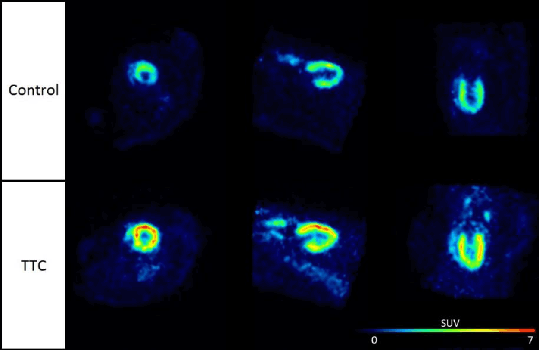Print version
Search Pub Med
| 155P London, UK Pharmacology 2017 |
Metabolic dysfunction in a rat model of takotsubo cardiomyopathy
Introduction: Takotsubo cardiomyopathy (TTC) is an acute cardiac condition characterised by left ventricular wall motion abnormalities with an in-hospital mortality rate comparable to acute coronary syndrome (Templin et al., 2015). Recent evidence suggests that a reduction in the capacity to match cardiac ATP supply to demand may be involved in its pathophysiology (Dawson et al., 2015). This study aims to characterise this dysfunction in order to identify potential therapeutic targets.
Method: To gain a deeper understanding of this metabolic disturbance an animal model of TTC was developed and induced by IP injection of isoprenaline (100 mg/kg, in 0.9% saline) to female Sprague Dawley rats (250 ± 41 g). Three days after model induction mitochondria were isolated from the left ventricle of TTC rats (n=8) and age-matched controls (n=8) and respiration was monitored in the presence of pyruvate/malate in an extracellular flux (XF) analyser (Rogers et al., 2011). A separate cohort of animals (n=8) underwent 18F-FDG PET scans at baseline and on day 3 post-isoprenaline to investigate changes in glucose uptake.
Results: PET scans revealed that 18F-FDG accumulation in the TTC rat myocardium was significantly increased compared to control (mean SUV = 3.5 and 2.8 respectively, n=8, P=0.002). The oxygen consumption rate (OCR) at respiration states 2, 3, 3u and 4o did not differ significantly in mitochondria isolated from control and TTC myocardium (n=8). The spare respiratory capacity was also unchanged in pyruvate stimulated mitochondria.
Conclusions: This suggests that in the presence of pyruvate the integrity and function of the mitochondria remain intact. An increase in glucose uptake may indicate that the energetic insufficiency is the result of upstream processes in energy production such as substrate uptake and utilisation. Further investigation will clarify if mitochondrial function is substrate dependant and if metabolic modulation presents a viable treatment strategy.

References:
1. Dawson D et al. (2015). JACC: Cardiovascular Imaging 8: 985-987.
2. Rogers G et al. (2011). PLoS ONE 6: 21746.
3. Templin C et al. (2015). New England Journal of Medicine 373: 929-938.

